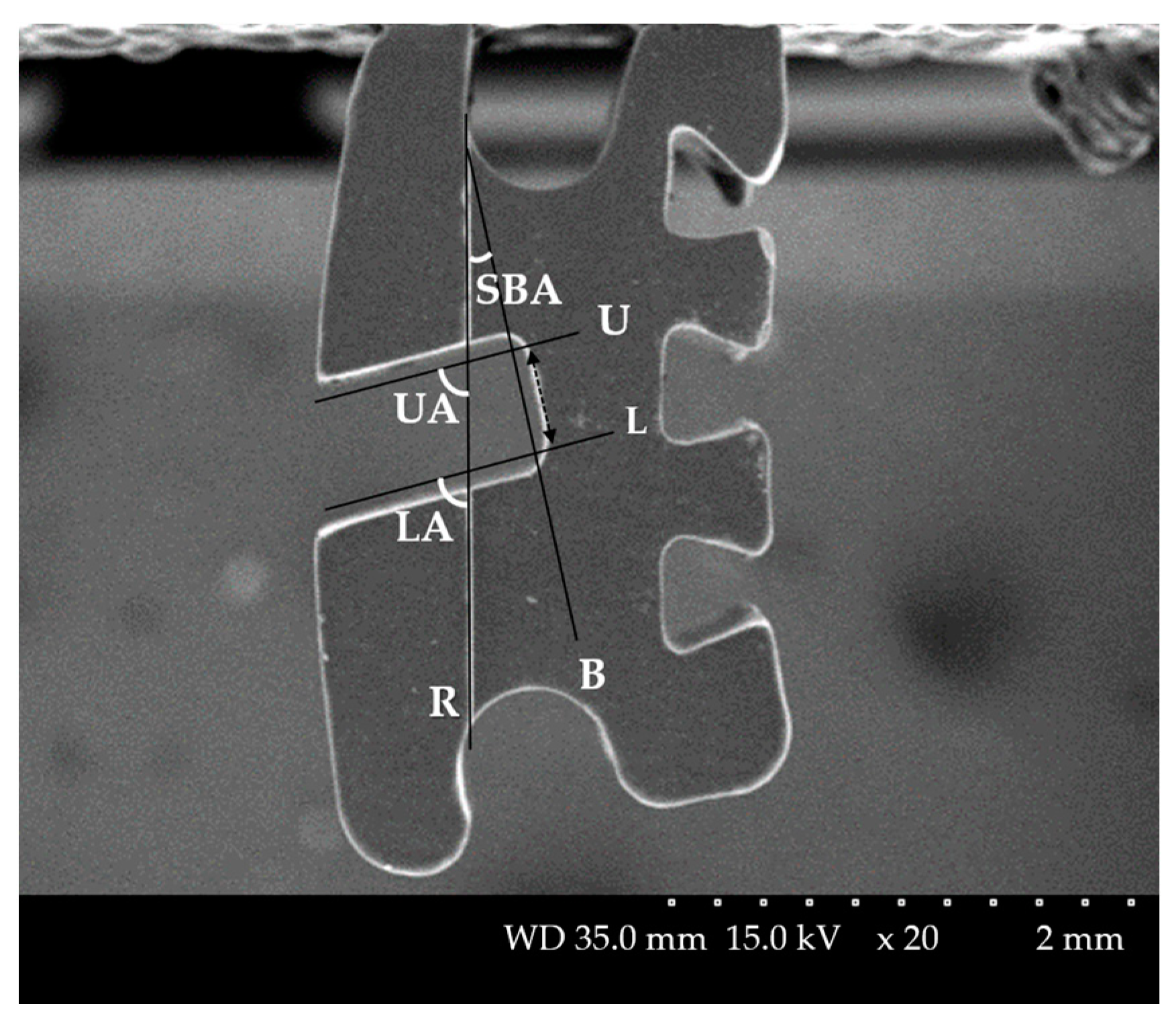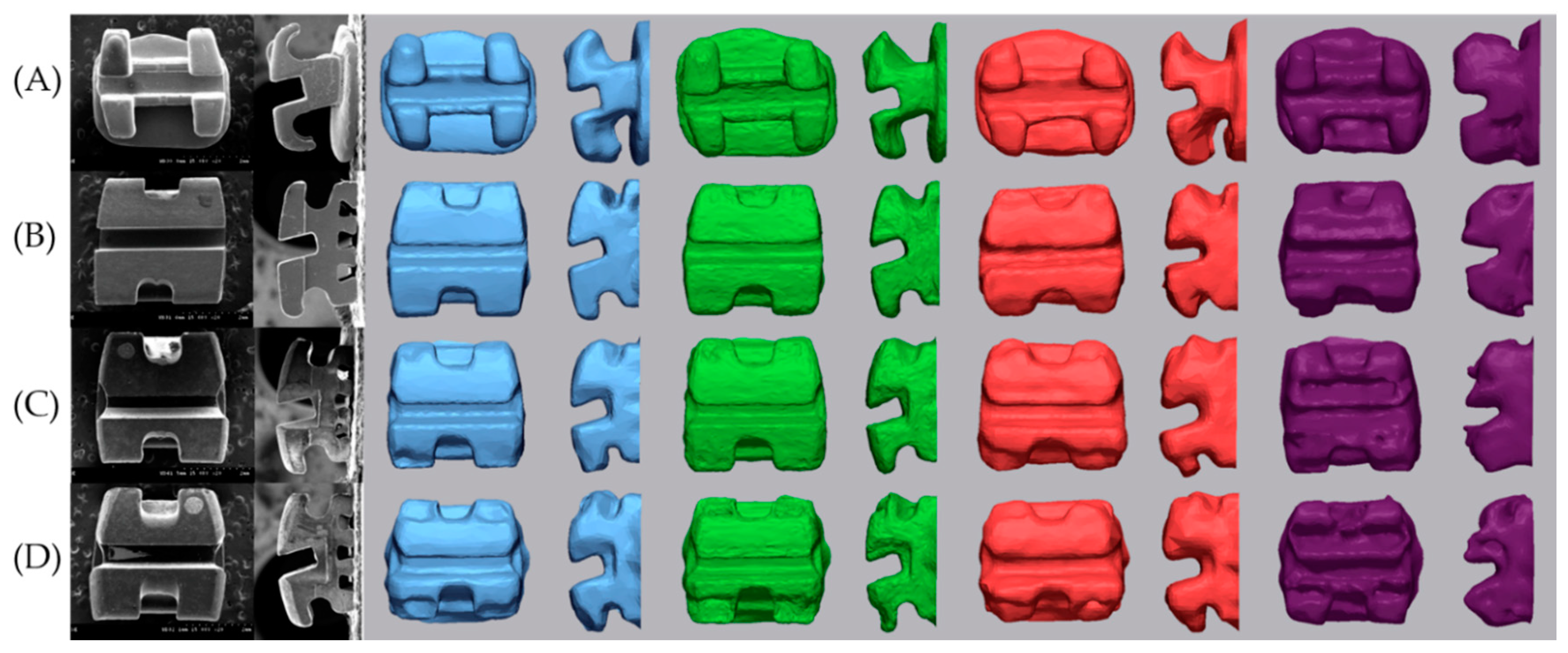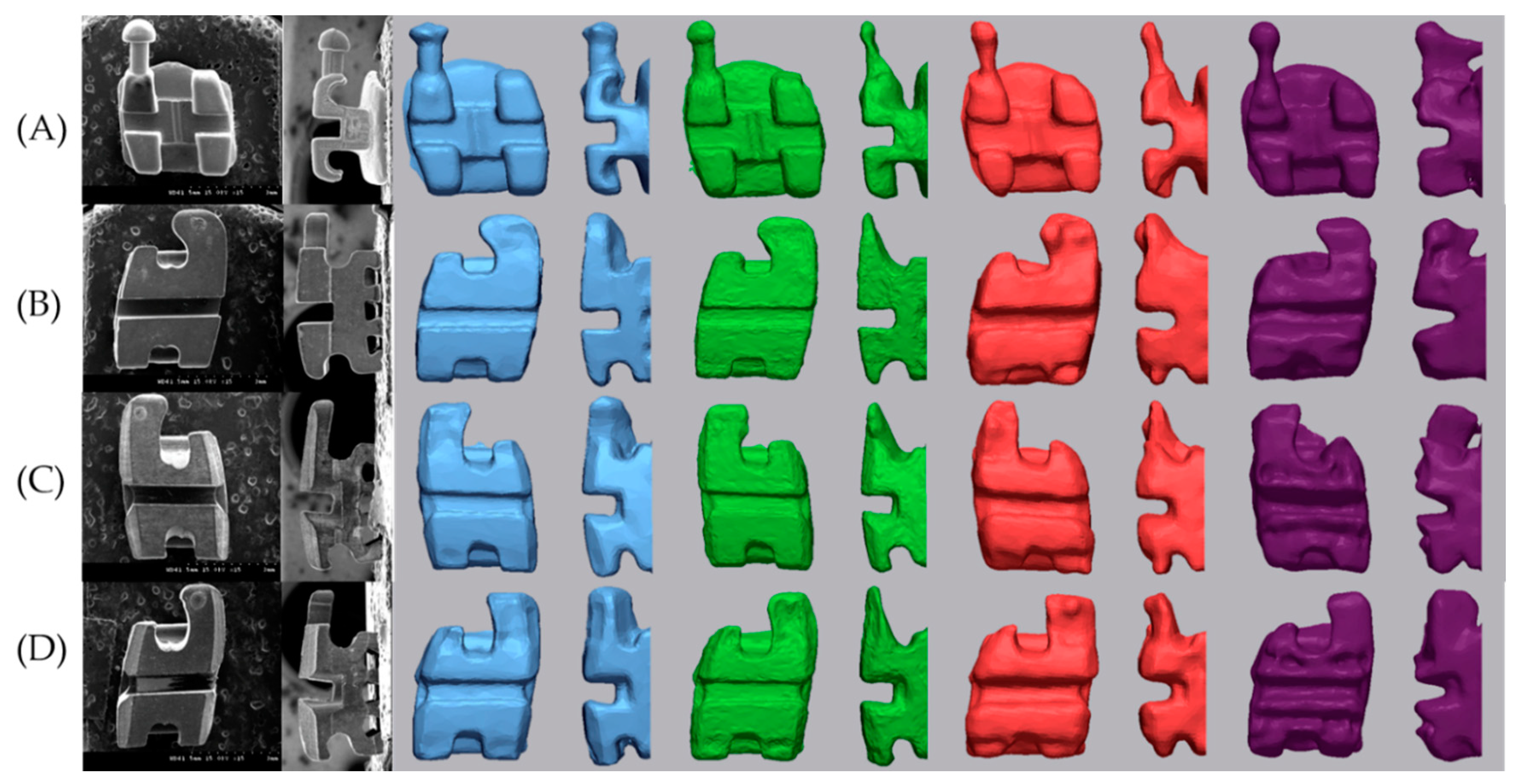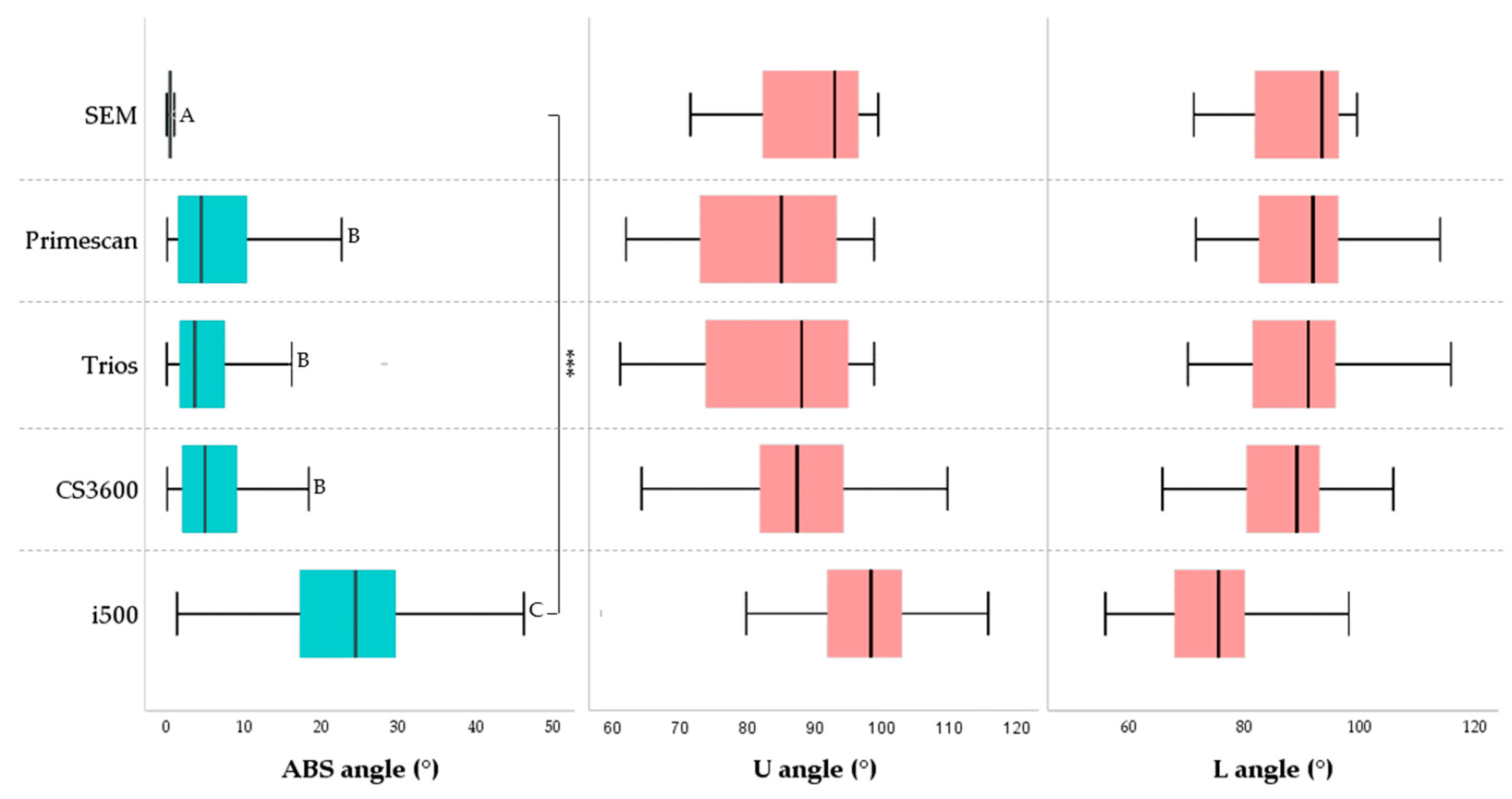Scanning Accuracy of Bracket Features and Slot Base Angle in Different Bracket Materials by Four Intraoral Scanners: An In Vitro Study
Abstract
1. Introduction
2. Materials and Methods
2.1. Study Model Design
2.2. Scanning Electron Microscope (SEM)
2.3. Scanning Process
2.4. Datasets
2.5. Scan Data Analysis
2.5.1. Setting the Axis of the Bracket
2.5.2. Bracket Slot Angle
2.5.3. Superimposition
2.6. Statistical Analysis
3. Results
3.1. Precision
3.2. Trueness
3.2.1. Difference of SBA
3.2.2. ABS Angle
4. Discussion
5. Conclusions
Author Contributions
Funding
Data Availability Statement
Conflicts of Interest
References
- Park, J.Y.; Kim, D.; Han, S.S.; Yu, H.S.; Cha, J.Y. Three-dimensional comparison of 2 digital models obtained from cone-beam computed tomographic scans of polyvinyl siloxane impressions and plaster models. Imaging Sci. Dent. 2019, 49, 257–263. [Google Scholar] [CrossRef]
- Kim, S.Y.; Shin, Y.S.; Jung, H.D.; Hwang, C.J.; Baik, H.S.; Cha, J.Y. Precision and trueness of dental models manufactured with different 3-dimensional printing techniques. Am. J. Orthod. Dentofac. Orthop. 2018, 153, 144–153. [Google Scholar] [CrossRef] [PubMed]
- Favero, C.S.; English, J.D.; Cozad, B.E.; Wirthlin, J.O.; Short, M.M.; Kasper, F.K. Effect of print layer height and printer type on the accuracy of 3-dimensional printed orthodontic models. Am. J. Orthod. Dentofac. Orthop. 2017, 152, 557–565. [Google Scholar] [CrossRef] [PubMed]
- Graf, S.; Cornelis, M.A.; Gameiro, G.H.; Cattaneo, P.M. Computer-aided design and manufacture of hyrax devices: Can we really go digital? Am. J. Orthod. Dentofac. Orthop. 2017, 152, 870–874. [Google Scholar] [CrossRef] [PubMed]
- Park, J.H.; Hwang, C.J.; Choi, Y.J.; Houschyar, K.S.; Yu, J.H.; Bae, S.Y.; Cha, J.Y. Registration of digital dental models and cone-beam computed tomography images using 3-dimensional planning software: Comparison of the accuracy according to scanning methods and software. Am. J. Orthod. Dentofac. Orthop. 2020, 157, 843–851. [Google Scholar] [CrossRef]
- Yang, L.; Yin, G.; Liao, X.; Yin, X.; Ye, N. A novel customized ceramic bracket for esthetic orthodontics: In Vitro study. Prog. Orthod. 2019, 20, 39. [Google Scholar] [CrossRef]
- Yoon, J.H.; Yu, H.S.; Choi, Y.J.; Choi, T.H.; Choi, S.H.; Cha, J.Y. Model Analysis of Digital Models in Moderate to Severe Crowding: In Vivo Validation and Clinical Application. BioMed Res. Int. 2018, 2018, 8414605. [Google Scholar] [CrossRef] [PubMed]
- Sha, H.N.; Lim, S.Y.; Kwon, S.M.; Cha, J.Y. Camouflage treatment for skeletal Class III patient with facial asymmetry using customized bracket based on CAD/CAM virtual orthodontic system: A case report. Angle Orthod. 2020, 90, 607–618. [Google Scholar] [CrossRef]
- Archambault, A.; Lacoursiere, R.; Badawi, H.; Major, P.W.; Carey, J.; Flores-Mir, C. Torque Expression in Stainless Steel Orthodontic BracketsA Systematic Review. Angle Orthod. 2010, 80, 201–210. [Google Scholar] [CrossRef]
- Badawi, H.M.; Toogood, R.W.; Carey, J.P.; Heo, G.; Major, P.W. Torque expression of self-ligating brackets. Am. J. Orthod. Dentofac. Orthop. 2008, 133, 721–728. [Google Scholar] [CrossRef]
- Gioka, C.; Eliades, T. Materials-induced variation in the torque expression of preadjusted appliances. Am. J. Orthod. Dentofac. Orthop. 2004, 125, 323–328. [Google Scholar] [CrossRef] [PubMed]
- Morina, E.; Eliades, T.; Pandis, N.; Jäger, A.; Bourauel, C. Torque expression of self-ligating brackets compared with conventional metallic, ceramic, and plastic brackets. Eur. J. Orthod. 2008, 30, 233–238. [Google Scholar] [CrossRef] [PubMed]
- Yun, D.S.; Choi, D.S.; Jang, I.S.; Cha, B.K. Clinical application of an intraoral scanner for serial evaluation of orthodontic tooth movement: A preliminary study. Korean J. Orthod. 2018, 48, 262–267. [Google Scholar] [CrossRef] [PubMed]
- Mah, J.; Sachdeva, R. Computer-assisted orthodontic treatment: The SureSmile process. Am. J. Orthod. Dentofac. Orthop. 2001, 120, 85–87. [Google Scholar] [CrossRef] [PubMed]
- Alford, T.J.; Roberts, W.E.; Hartsfield Jr, J.K.; Eckert, G.J.; Snyder, R.J. Clinical outcomes for patients finished with the SureSmile™ method compared with conventional fixed orthodontic therapy. Angle Orthod. 2011, 81, 383–388. [Google Scholar] [CrossRef]
- Jung, Y.R.; Park, J.M.; Chun, Y.S.; Lee, K.N.; Kim, M.J. Accuracy of four different digital intraoral scanners: Effects of the presence of orthodontic brackets and wire. Int. J. Comput. Dent. 2016, 19, 203–215. [Google Scholar]
- Park, J.M.; Choi, S.A.; Myung, J.Y.; Chun, Y.S.; Kim, M.J. Impact of Orthodontic Brackets on the Intraoral Scan Data Accuracy. BioMed Res. Int. 2016, 2016, 5075182. [Google Scholar] [CrossRef]
- Kurz, M.; Attin, T.; Mehl, A. Influence of material surface on the scanning error of a powder-free 3D measuring system. Clin. Oral Investig. 2015, 19, 2035–2043. [Google Scholar] [CrossRef]
- Song, J.H.; Kim, M.J. Accuracy on Scanned Images of Full Arch Models with Orthodontic Brackets by Various Intraoral Scanners in the Presence of Artificial Saliva. BioMed Res. Int. 2020, 2020, 2920804. [Google Scholar] [CrossRef]
- International Organization for Standardization. ISO 5725-1: Accuracy (Trueness and Precision) of Measurement Methods and Results-Part 1: General Principles and Definitions; International Organization for Standardization: Geneva, Switzerland, 1994. [Google Scholar]
- Vogel, A.B.; Kilic, F.; Schmidt, F.; Ruebel, S.; Lapatki, B.G. Optical 3D scans for orthodontic diagnostics performed on full-arch impressions. J. Orofac. Orthop. 2015, 76, 493–507. [Google Scholar] [CrossRef]
- Li, H.; Lyu, P.; Wang, Y.; Sun, Y. Influence of object translucency on the scanning accuracy of a powder-free intraoral scanner: A laboratory study. J. Prosthet. Dent. 2017, 117, 93–101. [Google Scholar] [CrossRef]
- International Organization for Standardization. ISO, 27020: Dentistry: Brackets and Tubes for Use in Orthodontics; International Organization for Standardization: Geneva, Switzerland, 1994. [Google Scholar]
- Major, T.W.; Carey, J.P.; Nobes, D.S.; Major, P.W. Orthodontic Bracket Manufacturing Tolerances and Dimensional Differences between Select Self-Ligating Brackets. J. Dent. Biomech. 2010, 2010, 781321. [Google Scholar] [CrossRef]
- Araujo, A.V.; Guedes, A.B.; Cunha, E.F.; Frigo, L.; Fernandes, A.P.; Pessoa, P.S.; Carvalho, P.E. Precision brackets for upper lateral incisors in Bioprogressive therapy. Microsc. Res. Tech. 2019, 82, 2049–2053. [Google Scholar] [CrossRef] [PubMed]
- Sebanc, J.; Brantley, W.A.; Pincsak, J.J.; Conover, J.P. Variability of effective root torque as a function of edge bevel on orthodontic arch wires. Am. J. Orthod. 1984, 86, 43–51. [Google Scholar] [CrossRef]
- Siatkowski, R.E. Loss of anterior torque control due to variations in bracket slot and archwire dimensions. J. Clin. Orthod. 1999, 33, 508. [Google Scholar]
- Arezoobakhsh, A.; Shayegh, S.S.; Ghomi, A.J.; Hakimaneh, S.M.R. Comparison of marginal and internal fit of 3-unit zirconia frameworks fabricated with CAD-CAM technology using direct and indirect digital scans. J. Prosthet. Dent. 2020, 123, 105–112. [Google Scholar] [CrossRef] [PubMed]
- Richert, R.; Goujat, A.; Venet, L.; Viguie, G.; Viennot, S.; Robinson, P.; Farges, J.-C.; Fages, M.; Ducret, M. Intraoral Scanner Technologies: A Review to Make a Successful Impression. J. Healthc. Eng. 2017, 2017, 8427595. [Google Scholar] [CrossRef]
- Taneva, E.; Kusnoto, B.; Evans, C.A. 3D scanning, imaging, and printing in orthodontics. Issues Contemp. Orthod. 2015, 147–188. [Google Scholar] [CrossRef]
- Imburgia, M.; Logozzo, S.; Hauschild, U.; Veronesi, G.; Mangano, C.; Mangano, F.G. Accuracy of four intraoral scanners in oral implantology: A comparative in vitro study. BMC Oral Health 2017, 17, 1–13. [Google Scholar] [CrossRef]
- Kim, R.J.Y.; Park, J.M.; Shim, J.S. Accuracy of 9 intraoral scanners for complete-arch image acquisition: A qualitative and quantitative evaluation. J. Prosthet. Dent. 2018, 120, 895–903. [Google Scholar] [CrossRef]
- Latham, J.; Ludlow, M.; Mennito, A.; Kelly, A.; Evans, Z.; Renne, W. Effect of scan pattern on complete-arch scans with 4 digital scanners. J. Prosthet. Dent. 2020, 123, 85–95. [Google Scholar] [CrossRef] [PubMed]
- Mangano, F.; Gandolfi, A.; Luongo, G.; Logozzo, S. Intraoral scanners in dentistry: A review of the current literature. BMC Oral Health 2017, 17, 1–11. [Google Scholar] [CrossRef] [PubMed]
- Mangano, F.G.; Admakin, O.; Bonacina, M.; Lerner, H.; Rutkunas, V.; Mangano, C. Trueness of 12 intraoral scanners in the full-arch implant impression: A comparative in vitro study. BMC Oral Health 2020, 20, 1–21. [Google Scholar] [CrossRef] [PubMed]
- Park, H.N.; Lim, Y.J.; Yi, W.J.; Han, J.S.; Lee, S.P. A comparison of the accuracy of intraoral scanners using an intraoral environment simulator. J. Adv. Prosthodont. 2018, 10, 58–64. [Google Scholar] [CrossRef]
- Kim, J.S.; Park, J.M.; Kim, M.J.; Heo, S.J.; Kim, M.A. Comparison of experience curves between two 3-dimensional intraoral scanners. J. Prosthet. Dent. 2016, 116, 221–230. [Google Scholar] [CrossRef]
- Lim, J.H.; Park, J.M.; Kim, M.J.; Heo, S.J.; Myung, J.Y. Comparison of digital intraoral scanner reproducibility and image trueness considering repetitive experience. J. Prosthet. Dent. 2018, 119, 225–232. [Google Scholar] [CrossRef]







| Material | Model Name | Manufacturer | Dimension (Inches) | Position | Prescription; Torque (°) |
|---|---|---|---|---|---|
| Stainless steel | Bionic metal | Ortho Technology, Lutz, FL, USA | 022 | Model A #11–15 | MBT Central incisor; +17° Lateral incisor; +10° Canine; 0° or −7° (Metal, Ceramic; 0°, Resin, Resinmetal; −7°) Premolar; −7° |
| Polycrystalline alumina | Reflection ceramic | Ortho Technology, Lutz, FL, USA | 022 | Model A #21–25 | |
| Composite | Purfit I resin | US Orthodontic products, Norwalk, CA, USA | 022 | Model B #11–15 | |
| Composite, stainless steel slot | Purfit II resin (resinmetal); same design as the Purfit I resin bracket, and only slots are metal | US Orthodontic products, Norwalk, CA, USA | 022 | Model B #21–25 |
| Product | Manufacturer | Scanner Technology | Light Source | Acqusition Method | Software Version |
|---|---|---|---|---|---|
| Primescan | Dentsply Sirona, York, PA, USA | Confocal microscopy | Light | Close to Individual image | 5.1 |
| Trios 3 | 3shape, Copenhagen, Denmark | Confocal microscopy | Light | Ultrafast optical sectioning technique | 1.4.7.3 |
| CS3600 | Carestream, Rochester, NY, USA | Triangulation | Light | Video sequence | 3.1.0 |
| i500 | Medit, Seoul, Republic of Korea | Trianulation | Light | Individual image | 2.2.4.7 |
| RMS (Mean ± SD, μm) | ||||||
|---|---|---|---|---|---|---|
| Bracket Material | Primescan | Trios 3 | CS3600 | i500 | Total | p |
| Metal | 27.15 ± 9.17 aA | 29.08 ± 4.46 bA | 53.24 ± 17.62 B | 59.57 ± 12.36 aC | 42.26 ± 18.67 a | *** |
| Ceramic | 26.88 ± 10.23 aA | 24.28 ± 4.24 aA | 54.50 ± 13.30 B | 68.65 ± 18.70 bC | 43.58 ± 22.62 ab | *** |
| Resin | 39.53 ± 10.80 bB | 22.79 ± 4.84 aA | 56.95 ± 14.87 C | 73.93 ± 13.15 bD | 48.30 ± 22.32 b | *** |
| Resinmetal | 39.81 ± 16.82 bB | 27.39 ± 5.30 bA | 55.75 ± 13.85 C | 70.43 ± 15.59 bD | 48.34 ± 21.18 b | *** |
| Total | 33.34 ± 13.70 B | 25.89 ± 5.31 A | 55.11 ± 14.95 C | 68.14 ± 15.95 D | *** | |
| p | *** | *** | NS | *** | ** | |
| Difference of SBA, Median (Q1–Q3), (°) | |||||||
|---|---|---|---|---|---|---|---|
| Bracket | SEM | Primescan | Trios 3 | CS3600 | p | IOS | |
| Central incisor | Metal | 0.46 (0.08–0.84) | 1.00 (0.64–1.81) | 2.73 (1.70–3.70) | 1.67 (1.12–3.08) | * | p < 0.001 |
| Ceramic | 0.31 (0.19–0.72) | 0.69 (0.41–0.82) | 3.77 (3.37–5.26) | 10.97 (6.00–16.69) | * | ||
| Resin | 0.59 (0.18–0.80) | 1.30 (0.70–3.80) | 0.81 (0.68–2.35) | 5.76 (2.45–7.27) | * | ||
| Resinmetal | 0.35 (0.12–0.80) | 3.41 (2.31–3.55) | 1.04 (0.64–2.53) | 3.61 (3.30–4.92) | * | ||
| Total | 0.45 ± 0.33 A | 1.64 ± 1.19 B | 2.57 ± 1.54 B | 4.87 ± 4.54 C | |||
| p | NS | * | * | * | |||
| Lateral incisor | Metal | 0.44 (0.29–0.80) | 6.31 (4.85–7.28) | 6.11 (4.80–8.66) | 8.28 (4.98–10.68) | * | p < 0.001 |
| Ceramic | 0.20 (0.04–0.35) | 1.29 (0.82–1.66) | 0.69 (0.45–3.47) | 2.93 (0.86–3.79) | NS | ||
| Resin | 0.35 (0.11–0.62) | 1.45 (0.29–2.12) | 0.48 (0.23–0.99) | 1.47 (0.53–5.47) | NS | ||
| Resinmetal | 0.92 (0.59–1.64) | 1.46 (0.44–5.97) | 2.88 (2.62–3.74) | 1.85 (0.72–3.82) | NS | ||
| Total | 0.53 ± 0.46 A | 3.53 ± 2.77 B | 3.74 ± 2.99 B | 4.03 ± 0.81 C | |||
| p | NS | * | ** | * | |||
| Canine | Metal | 0.39 (0.32–0.47) | 2.11 (1.04–3.43) | 1.18 (0.53–2.88) | 4.06 (1.50–6.48) | * | p < 0.001 |
| Ceramic | 0.16 (0.03–0.32) | 3.84 (1.64–4.87) | 1.69 (1.10–3.59) | 12.76 (4.60–17.79) | * | ||
| Resin | 0.38 (0.06–0.70) | 1.54 (0.53–2.67) | 0.71 (0.06–1.33) | 4.67 (3.17–5.95) | * | ||
| Resinmetal | 0.28 (0.13–0.75) | 2.09 (0.74–4.74) | 2.83 (1.50–3.69) | 6.18 (2.07–6.91) | * | ||
| Total | 0.33 ± 0.25 A | 2.56 ± 1.50 B | 1.74 ± 1.33 B | 5.85 ± 4.55 C | |||
| p | NS | NS | NS | NS | |||
| 1st Premolar | Metal | 0.35 (0.24–0.45) | 0.90 (0.82–1.11) | 1.45 (1.11–2.04) | 4.49 (2.41–5.63) | *** | p < 0.001 |
| Ceramic | 0.14 (0.05–0.17) | 0.54 (0.19–1.06) | 0.66 (0.30–0.92) | 6.16 (5.80–10.10) | * | ||
| Resin | 0.44 (0.29–0.63) | 0.53 (0.34–0.68) | 0.39 (0.20–0.61) | 1.47 (0.78–4.76) | * | ||
| Resinmetal | 0.29 (0.14–0.56) | 0.58 (0.20–1.30) | 0.59 (0.52–1.27) | 8.00 (4.58–11.54) | * | ||
| Total | 0.31 ± 0.19 A | 0.74 ± 0.40 B | 1.01 ± 0.68 B | 5.23 ± 3.40 C | * | ||
| p | NS | NS | * | * | |||
| 2nd Premolar | Metal | 0.31 (0.10–0.77) | 2.61 (1.47–2.89) | 1.80 (1.03–2.30) | 2.80 (0.78–4.52) | * | p < 0.001 |
| Ceramic | 0.32 (0.13–0.43) | 0.77 (0.51–1.22) | 0.40 (0.19–0.83) | 6.48 (6.36–9.46) | * | ||
| Resin | 0.27 (0.18–0.48) | 1.02 (0.12–1.39) | 0.47 (0.21–1.05) | 5.39 (1.48–7.68) | * | ||
| Resinmetal | 0.28 (0.13–0.75) | 1.47 (0.50–2.85) | 1.35 (0.80–1.79) | 5.55 (3.02–16.01) | * | ||
| Total | 0.35 ± 0.25 A | 1.55 ± 1.03 B | 1.15 ± 0.84 B | 5.40 ± 5.16 C | |||
| p | NS | * | * | NS | |||
| All teeth | 0.39 ± 0.31 A | 1.96 ± 0.16 B | 2.04 ± 1.95 B | 5.21 ± 4.32 C | |||
| ABS Angle (Mean ± SD, °) | |||||||
|---|---|---|---|---|---|---|---|
| Bracket Material | SEM | Primescan | Trios 3 | CS3600 | i500 | Total | p |
| Metal | 0.44 ± 0.25 A | 2.99 ± 3.76 aB | 3.46 ± 3.39 aB | 5.60 ± 4.79 B | 18.60 ± 8.81 aC | 7.01 ± 8.36 a | *** |
| Ceramic | 0.52 ± 0.25 A | 6.39 ± 4.71 bB | 5.94 ± 5.79 abB | 6.62 ± 5.38 B | 30.11 ± 8.51 bC | 10.31 ± 11.84 b | *** |
| Resin | 0.34 ± 0.17 A | 5.76 ± 6.08 abB | 6.07 ± 5.48 abB | 5.30 ± 5.72 B | 27.63 ± 11.62 bC | 9.37 ± 11.82 ab | *** |
| Resinmetal | 0.62 ± 0.37 A | 16.95 ± 5.70 cC | 8.65 ± 6.50 bB | 8.59 ± 5.88 B | 23.76 ± 6.29 abD | 12.18 ± 9.53 b | *** |
| Total | 0.48 ± 0.29 A | 7.00 ± 7.08 B | 5.52 ± 5.37 B | 6.34 ± 5.40 B | 23.74 ± 10.02 C | *** | |
| p | NS | *** | ** | NS | *** | *** | |
Publisher’s Note: MDPI stays neutral with regard to jurisdictional claims in published maps and institutional affiliations. |
© 2021 by the authors. Licensee MDPI, Basel, Switzerland. This article is an open access article distributed under the terms and conditions of the Creative Commons Attribution (CC BY) license (http://creativecommons.org/licenses/by/4.0/).
Share and Cite
Shin, S.-H.; Yu, H.-S.; Cha, J.-Y.; Kwon, J.-S.; Hwang, C.-J. Scanning Accuracy of Bracket Features and Slot Base Angle in Different Bracket Materials by Four Intraoral Scanners: An In Vitro Study. Materials 2021, 14, 365. https://doi.org/10.3390/ma14020365
Shin S-H, Yu H-S, Cha J-Y, Kwon J-S, Hwang C-J. Scanning Accuracy of Bracket Features and Slot Base Angle in Different Bracket Materials by Four Intraoral Scanners: An In Vitro Study. Materials. 2021; 14(2):365. https://doi.org/10.3390/ma14020365
Chicago/Turabian StyleShin, Seon-Hee, Hyung-Seog Yu, Jung-Yul Cha, Jae-Sung Kwon, and Chung-Ju Hwang. 2021. "Scanning Accuracy of Bracket Features and Slot Base Angle in Different Bracket Materials by Four Intraoral Scanners: An In Vitro Study" Materials 14, no. 2: 365. https://doi.org/10.3390/ma14020365
APA StyleShin, S.-H., Yu, H.-S., Cha, J.-Y., Kwon, J.-S., & Hwang, C.-J. (2021). Scanning Accuracy of Bracket Features and Slot Base Angle in Different Bracket Materials by Four Intraoral Scanners: An In Vitro Study. Materials, 14(2), 365. https://doi.org/10.3390/ma14020365







